Bulletin – September 2017 Australian Economy The Resources Economy and the Terms of Trade Boom
- Download 499KB
Abstract
The transition from the investment to the production phase of the resources boom is nearly complete. The adjustment has affected industries beyond the resources sector, which has amplified the impact of the resource investment boom on the Australian economy. The value added and employment shares of this broader ‘resources economy’ have retreated from their 2011/12 peaks, but remain above their pre-boom averages.
Introduction
After a decade of adjustment following the unprecedented boom in commodity prices from the mid 2000s to late 2011, conditions facing the resources sector appear to be stabilising (Graph 1).[1] Almost all of the resource investment projects committed to during the boom are now complete; just a few liquefied natural gas (LNG) projects remain under construction. Aside from these LNG projects, resource companies have shifted their focus to increasing export volumes by boosting productivity rather than investing in additional capacity. In short, the transition from the investment to the production phase of the mining boom is nearly complete.
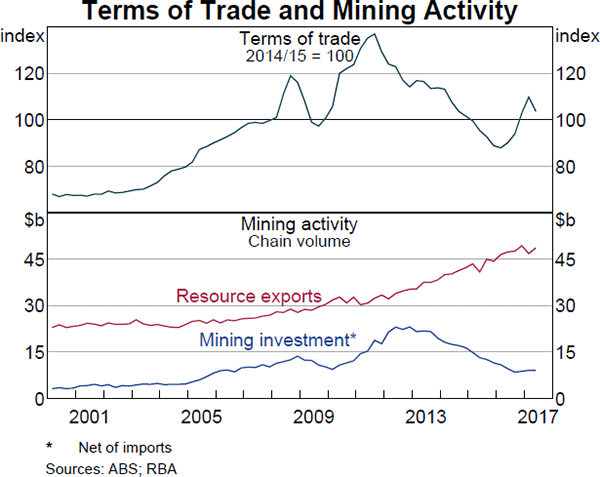
The adjustment to this transition has affected industries beyond the resources sector. Industries that provide inputs to resource extraction and investment activities have also had to adjust, which has amplified the effects of the boom on the Australian economy. This article uses the input-output tables produced by the Australian Bureau of Statistics (ABS) to examine the impact of the transition on activity and prices in the resources and resources-exposed sectors. Information from the Bank's business liaison program is used to provide insights on the outlook for activity and employment in these sectors.[2]
The Resources Economy
The extraction, processing and export of resources requires inputs from a wide range of industries outside the mining industry. For example, iron ore operations require inputs ranging from explosives produced by the manufacturing sector, replacement parts for mining vehicles from equipment suppliers, and external auditors from the business services sector. The resources sector, which is defined in this article as the mining and resource-specific manufacturing industries, is combined with these resources-exposed industries to make up the broader ‘resources economy’.[3]
The size of the resources economy is estimated using the input-output tables released by the ABS, which capture inter-industry linkages throughout the economy. Using the approach taken by Rayner and Bishop (2013), the nominal gross value added (GVA) of the resources-exposed sector is estimated from the spillovers from extraction and investment activity by the resources sector to other sectors (see Appendix A for a brief summary of the methodology and key assumptions).[4] The GVA of a sector is the value of goods and services it produces less the value of intermediate inputs it consumes; since the focus here is on the contribution to the domestic economy, imported inputs are netted out.[5] Nominal GVA estimates will capture changes in both the price and volume of activity.
Based on these estimates, the resources economy as a share of the total economy peaked at just over 18 per cent in 2011/12; almost double its pre-boom share (Graph 2). The increase in nominal GVA up to that time was driven by both higher commodity prices associated with strong demand for commodities from China, and the resulting increase in resource extraction and investment activity. Activity in both the resources and resources-exposed sectors increased as a result, with the increase in nominal GVA from the resources-exposed sectors larger than the increase from the resources sector. As resource companies typically contract out investment-related activity, almost all of the investment activity is assumed to be done by firms in the resources-exposed sector, such as civil and heavy engineering companies, rather than the resources sector.[6] In contrast, extraction activity is assumed to be primarily undertaken by the resources sector.
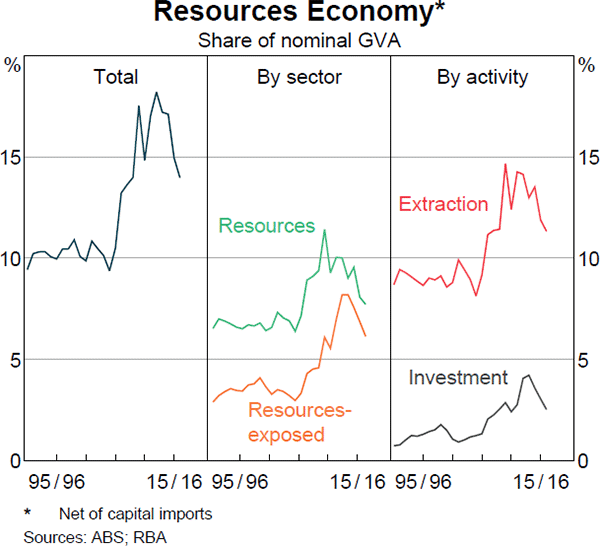
The share of the resources economy fell back to 14 per cent of nominal GVA in 2015/16 and is expected to have fallen further in 2016/17. The nominal share generated by resource extraction activity fell between 2011/12 and 2015/16, reflecting the large decline in commodity prices between late 2011 and early 2016, and despite the continued ramp-up in export volumes. This share will probably increase in the future; LNG extraction volumes are expected to increase as projects are completed and Australia's bulk commodity prices are forecast to remain above the late 2015/early 2016 troughs. In contrast, the share of nominal GVA generated by resource investment has a little further to fall, as the remaining LNG projects are completed; it should stabilise around the second half of next year. In real terms, the direction is relatively clear: the share of output coming from the resources economy should increase as the drag from the fall in mining investment dissipates and export production continues to increase; but what this means for the share of nominal GVA will depend on the evolution of commodity prices, which is harder to predict.
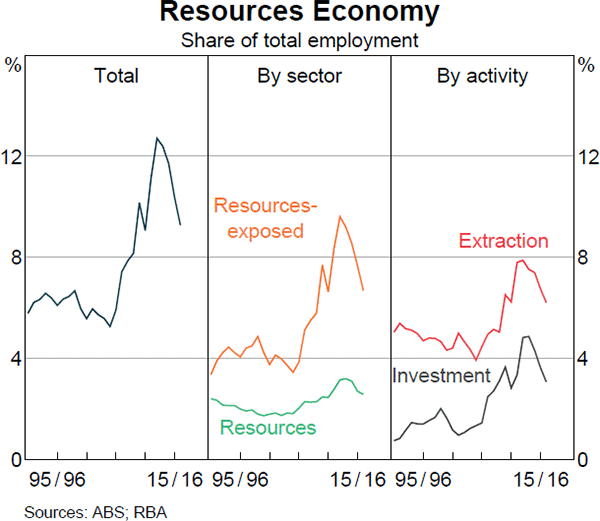
Employment in the resources economy increased alongside the increase in extraction and investment activity, peaking at 13 per cent of total employment in 2011/12.[7] As with GVA, most of the increase in employment was in the resources-exposed sectors, rather than the resources sector (Graph 3).[8] The extraction of resources is very capital intensive, requiring few workers relative to the value of its output compared with most other sectors. Since 2012/13, productivity gains achieved as commodity prices fell have seen employment in resource extraction shrink despite the doubling in export volumes. The resources economy's share of employment will continue to fall over the next year or so as the more labour-intensive investment activity is completed, but extraction-related employment is expected to stabilise as further productivity gains become more difficult to achieve.
Resource Investment Activity
A distinctive feature of the recent resource investment boom compared with previous mining investment cycles in Australia was the scale of investment in LNG projects. Compared with the coal and iron ore projects committed to during the boom, individual LNG projects were generally much larger, had longer lead times, took longer to construct and had higher imported content (Table 1). The long lead and construction times of these projects meant that oil and gas companies were less able than iron ore and coal companies to respond to the large declines in commodity prices by downgrading the capital intensity of committed projects.[9] Several of the LNG projects also experienced significant delays and cost over-runs, resulting in higher investment expenditure than initially anticipated (largely spent on domestic labour) to complete the projects. The prolonged construction time of these LNG projects has supported resource investment-related GVA and employment for longer than initially expected, extending the duration of the investment phase of the boom.
| Iron ore | Coal | LNG | |
|---|---|---|---|
| Timing of the peak in investment | Investment peaked in 2012/13, with most projects completed by 2016 | Investment peaked in 2012/13, with most projects completed by 2015 | Investment peaked in 2013/14, with most projects expected to be completed by 2019 |
| Number of projects | ~35 | ~75 | 12 |
| Median duration of projects | 2 years | 1¾ years | 5¼ years |
| Median project size(b) | Around $1½bn | Around $¼bn | Around $20bn |
|
(a) Infrastructure, expansion and sustaining projects recorded in the RBA's major
resource project database that reached a final investment decision after
2006; some projects may be missing from this database Sources: company reports; RBA |
|||
The resources-exposed construction industry, which includes civil and heavy engineering firms, experienced the largest increase in nominal GVA and employment as a result of the resource investment boom (Graph 4). Both the machinery & equipment manufacturing and business services sectors also experienced higher employment, activity and prices through to 2012/13. At the time, firms in these sectors commonly reported having record order books and strong margins. Labour costs escalated rapidly as the number of employees increased and large wage increases were granted due to competition for skilled labour. Yet the prices being paid by resource companies to resources-exposed firms for work were generally reported to be increasing at the same pace as labour costs or faster. High turnover of employees was common due to competition for skills; several firms noted that productivity of their workforce was declining because they had to hire less-experienced workers.
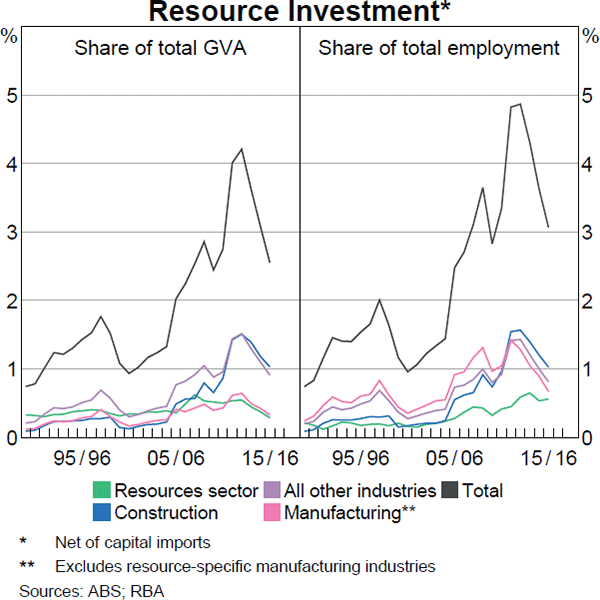
As the pipeline of new mining investment-related work shrank after 2012/13, labour demand eased significantly. Another factor influencing resource investment-related employment over this period was cost-cutting pressure from resource companies as commodity prices fell. Resource companies put pressure on contractors in the resources-exposed sectors to reduce their rates, which in turn led to reductions in headcount, wage growth and other costs to relieve pressure on margins. Some firms affected by this trend tried to diversify into non-resources areas of the economy, such as infrastructure and commercial construction, or enter overseas markets. However, strong competition and the time taken establishing credibility in new markets made this challenging.
With the exception of firms involved in completing the remaining LNG projects, conditions facing firms in sectors exposed to resource investment have stabilised since late 2016. There are several small new projects in train for commodities such as gold and lithium, and constraints on spending on the maintenance and replacement of existing mining machinery and equipment appear to have eased. Preliminary work has commenced on some projects required to replace depleted resources and maintain production at the elevated rates achieved as a result of the resource investment boom. This sustaining investment is expected to be sizeable, particularly for iron ore and LNG projects, totalling tens of billions of dollars over the next decade.
Resource Extraction Activity
Not surprisingly, the resources sector experienced the largest increase in nominal GVA and employment as a result of the increases in commodity prices and extraction activity through to 2011/12, but the increases for the business services sector were also sizeable (Graph 5). Increased extraction activity also supported the manufacturing and transport & storage sectors, in line with energy, chemicals, maintenance, and transport being the key intermediate inputs in resource extraction. The construction sector plays a relatively small role in resource extraction.
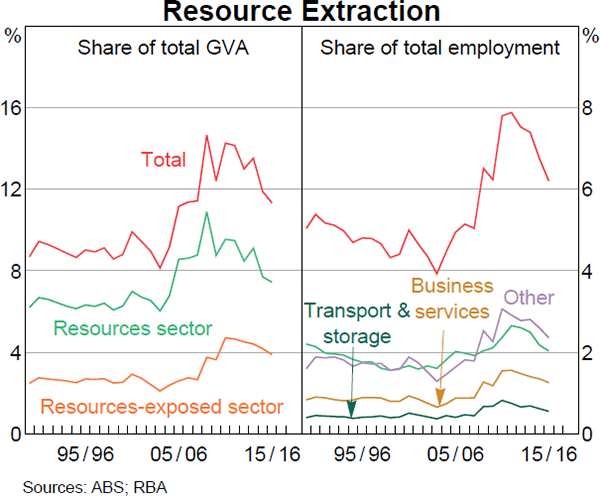
All else being equal, the increase in resource volumes seen since 2011/12 would have been expected to result in employment related to resource extraction continuing to increase. However, firms in these sectors responded to the pressure on margins resulting from lower commodity prices by improving productivity and lowering labour costs. For the resources sector, information from the Bank's liaison program suggests that these productivity gains were largely achieved by increasing capacity utilisation rates and improving the efficiency of processes and systems, rather than automating them.
Looking to the future, liaison suggests that employment in the resources and resources-exposed sectors is stabilising, and that further gains in productivity are difficult to achieve in the short term. However, there is likely to be downward pressure on employment in the resources sector over the longer term from the automation of mining machinery and equipment. Mining operations involving large open-cut mines (such as iron ore) are taking the lead on this front.
The completion of the remaining LNG projects is not expected to add much to employment because they require significantly fewer operational employees than iron ore and coal projects. Estimates based on company reports and liaison suggest that combined operational employment at the LNG projects will stabilise at a few thousand people, compared with tens of thousands involved in iron ore and coal operations. Over the long term, the experience of the mature LNG projects suggests that the new LNG projects are likely to be able to expand production through process improvements without increasing employment. LNG projects are already highly automated.
Assessment and Outlook for the Resources Economy
The resources economy's share of nominal GVA and employment has retreated from its resource investment boom highs, but remains above its pre-boom averages. The investment phase of the boom generated significant employment in the construction, manufacturing and business services sectors. It is drawing to a close with only a few LNG projects remaining under construction. Looking to the future, liaison suggests that resource companies are focusing on ‘incremental’ capacity expansions achieved through small-scale investments aimed at boosting productivity, rather than projects aimed at expanding capacity of the type seen during the investment boom. The automation of mining processes is one example of this type of investment. Some investment will also occur as a result of the need to invest in replacement mines and gas wells as existing resources are depleted to maintain production volumes.
Appendix A: Estimating the resources economy
The estimates of the size and industry composition of the resources economy in this article are based on the methodology outlined in Rayner and Bishop (2013). In summary, the methodology consists of three main steps:
- Estimating all of the final demand (or expenditure) in the economy that is related to resource extraction and investment, and then identifying the industries that produce these final goods and services. Industries that produce a final good (or service) are those that are responsible for the final steps in the production chain for a given product. For example, the resource extraction sector produces resource exports, and the heavy and civil engineering construction industry undertakes resource-related construction investment (net of capital imports).
- Using input-output (I-O) tables to calculate the value and industry composition of intermediate inputs required to meet this final demand. For example, I-O tables are used to calculate the value and industry composition of intermediate inputs required by the resource extraction sector to produce each dollar of resource exports, and the value and industry composition of intermediate inputs required by the heavy and civil engineering construction industry to undertake each dollar of resource-related construction investment.
- After making some simplifying assumptions, this information from I-O tables is used to transform the final demand related to resource extraction and investment into a measure of resources economy GVA that can be decomposed by industry. The GVA of an industry is the gross output of that industry less the intermediate inputs it uses to produce that output.
For financial years where I-O table data are not yet published, information from the closest I-O table(s) is used. For example, the latest vintage of published I-O table data is 2014/15, meaning that detailed data on industry linkages for 2015/16 is not available. For this year, the structure of the economy is assumed to be the same as in 2014/15. As a result, the analysis does not account for relative price changes that may have affected industry structure in 2015/16. Of particular importance is the relative price of resources sector output to its inputs. This price is proxied for by the ratio of the export price deflator and a weighted average input price deflator for the resources sector (Graph A1).
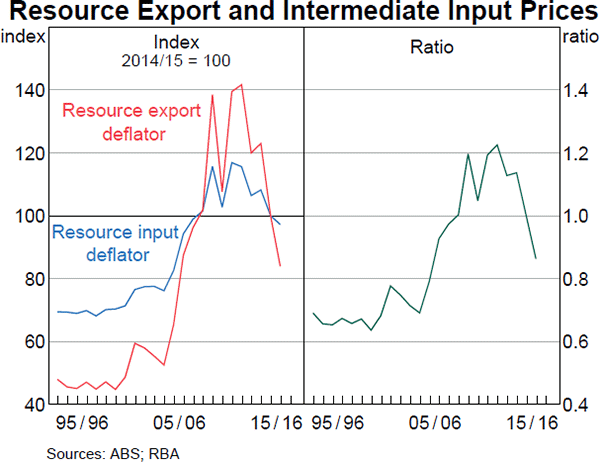
Mapping estimates of the resource extraction sector calculated using this methodology to the ABS' measure of the mining industry provides a cross-check to the analysis as, conceptually, subtracting resource-specific manufacturing output from our measure of resource extraction should reconcile these measures. The two series track each other closely (Graph A2).
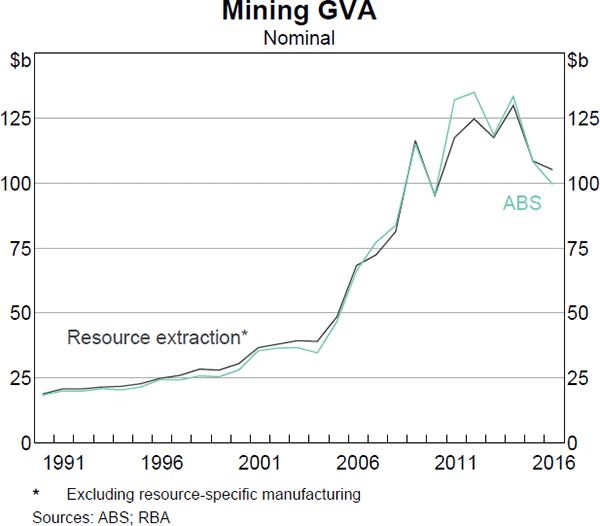
Footnotes
Sean Langcake completed this work in Economic Analysis Department and Emily Poole is from Economic Analysis Department. [*]
This article focuses on developments within the resources and resources-exposed sectors. For analysis of the impact of the mining investment boom on the non-resources sector, see Bishop et al (2013), Tulip (2014), Gorajek and Rees (2015) and Kent (2016). [1]
See RBA (2014) and Heath (2015) for information on the Bank's business liaison program. [2]
The resources sector is defined throughout as mining industries (coal mining, oil & gas extraction, iron ore mining, non-ferrous metal ore mining, non-metallic mineral mining, exploration & other mining support services) and some manufacturing industries closely linked to mining industries (iron & steel manufacturing, petroleum & coal product manufacturing, and basic non-ferrous metal manufacturing). The ABS definition of the mining industry does not include resource-specific manufacturing. [3]
The data are available up to 2014/15 and are used to estimate the nominal GVA of the resources economy up to 2015/16. Nominal GVA estimates are presented, rather than real GVA estimates, as the required price indices are not available. [4]
The difference between GVA and GDP is net taxes and subsidies. [5]
The methodology attributes different types of investment to different industries: mining non-residential construction gross fixed capital formation (GFCF) is attributed to engineering; mining machinery & equipment GFCF is attributed to machinery & equipment manufacturing; a distribution margin (calculated from the input-output tables) on mining machinery & equipment GFCF is attributed to the wholesale, retail & transport industries; and mining intellectual property (research & development, exploration) is attributed to the mining industry. [6]
See Doyle (2014) and Davis, McCarthy and Bridges (2016) for detailed discussions of developments in the Australian labour market over the course of the resource investment boom. [7]
These estimates are calculated by multiplying the final demand from the resources sector for a given industry's output by the number of employees in that sector. The underlying assumption is that an industry employs the same number of workers to meet a given amount of additional demand, irrespective of whether this demand comes from the resources sector, or any other part of the economy. As Rayner and Bishop (2013) point out, this seems like a reasonable assumption, with the possible exception of the construction industry, where labour productivity would be expected to be higher on resource projects than residential construction. [8]
An exception is the drilling plans of the three coal seam gas LNG projects in Queensland, which have been curtailed relative to initial expectations. [9]
References
Bishop J, C Kent, M Plumb and V Rayner (2013), ‘The Resources Boom and the Australian Economy: A Sectoral Analysis’, RBA Bulletin, March, pp 39–50.
Davis K, M McCarthy and J Bridges (2016), ‘The Labour Market during and after the Terms of Trade Boom’, RBA Bulletin, March, pp 1–10.
Doyle M-A (2014), ‘Labour Movements during the Resources Boom’, RBA Bulletin, December, pp 7–16.
Gorajek A and D Rees (2015), ‘Lower Bulk Commodity Prices and Their Effect on Economic Activity’, RBA Bulletin, September, pp 31–38.
Heath A (2015), ‘The Role of the RBA's Business Liaison Program’, Speech at the Urban Development Institute of Australia (WA Division Incorporated), Perth, 24 September.
Kent C (2016), ‘After the Boom’, Speech at the Bloomberg Breakfast, Sydney, 13 September.
Rayner V and J Bishop (2013), ‘Industry Dimensions of the Resource Boom: An Input-Output Analysis’, RBA Research Discussion Paper No 2013-02.
RBA (2014), ‘The RBA's Business Liaison Program’, Bulletin, September, pp 1–5.
Tulip P (2014), ‘The Effect of the Mining Boom on the Australian Economy’, RBA Bulletin, December, pp 17–22.